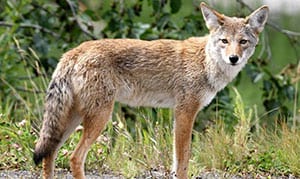
While summer wants us to open our doors and windows, there are still lots of reasons to keep your pets inside; multiple sightings of coyotes have been reported in neighborhoods all over Culver City. The death of a pet was reported in the downtown neighborhood just last week, July 3, 2020, and coyotes have been seen in Sunkist Park, Carlson Park, and Culver Crest as well.
The City monitors residents’ reports of coyote behavior in consultation with wildlife experts, and the City will take appropriate action to protect human safety. It is especially important that the City be notified of any aggressive coyote behavior towards humans. The three-year Culver City Coyote Study and Management Program, which is led by Dr. Eric G. Strauss, PhD from the Loyola Marymount University/Los Angeles’s Center for Urban Resilience began on July 1st.
The first year of the multi-year study includes in its suite of activities a review and assessment the City’s existing data relating to coyote distribution and activity. Dr. Strauss’s team has developed an online data visualization tool to depict a collection of community sightings and encounters with coyotes our area from 2013 to the present. The public is invited to view the online mapping tool.
Historically, coyotes have existed in and around Culver City, finding safe haven in areas including the Oil Fields backing Blair Hills, the Culver City Park and the Culver City Crest Neighborhood. Additionally, other areas within the City where dense brush is prevalent (hill sides, areas in and around the Ballona creek, etc.) also provide spots where coyotes can safely build dens and reproduce. It is also believed that the prolonged drought has limited potential food sources for the coyotes and thus drawn the coyotes to residential neighborhoods in search of food and water.
In general, coyotes regularly roam an area of about 2-5 square miles or whatever it takes to get enough food for the pack members. Normally, each coyote family group is a territorial and varies in number from 3 to 10 individuals. Coyotes are opportunistic, versatile carnivores that primarily eat small mammals, such as rabbits, ground squirrels, and mice. Coyotes tend to prefer fresh meat, but will eat significant amounts of fruits and vegetables during the autumn and winter months when their prey is scarce. Part of the coyotes’ success as a species is its dietary adaptability. This dietary flexibility, coupled with a lack of prey and closer proximity to residents, has led the coyotes to seek alternative food sources, including small pets, pet food, and fallen fruits and vegetables found in the backyards of homes.
If you are in immediate danger, or fear for your safety or the safety of others, dial 9-1-1.
Be your neighborhood’s eyes and ears and help maintain a safe community by immediately reporting any coyote presence or activity to the City:
- Dedicated Coyote Hotline: (310) 253-6141
- Email Animal Services
- Online coyote reporting form
- All reports should include both location, date and time of the activity, and any direct witness observations.


Be the first to comment